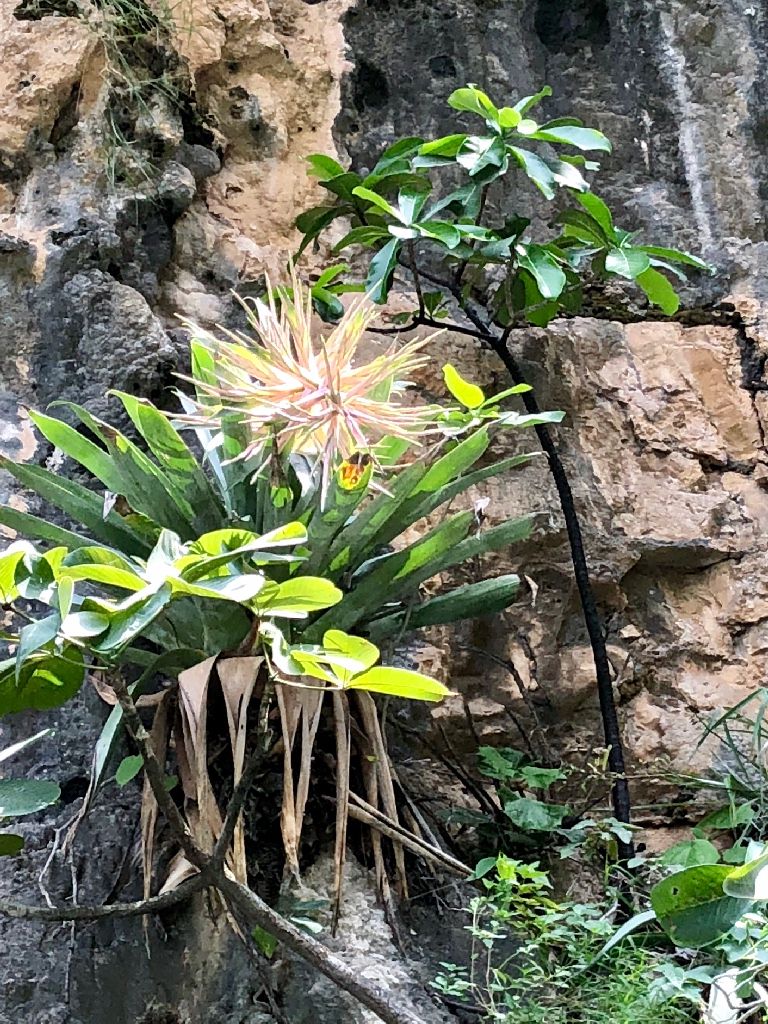
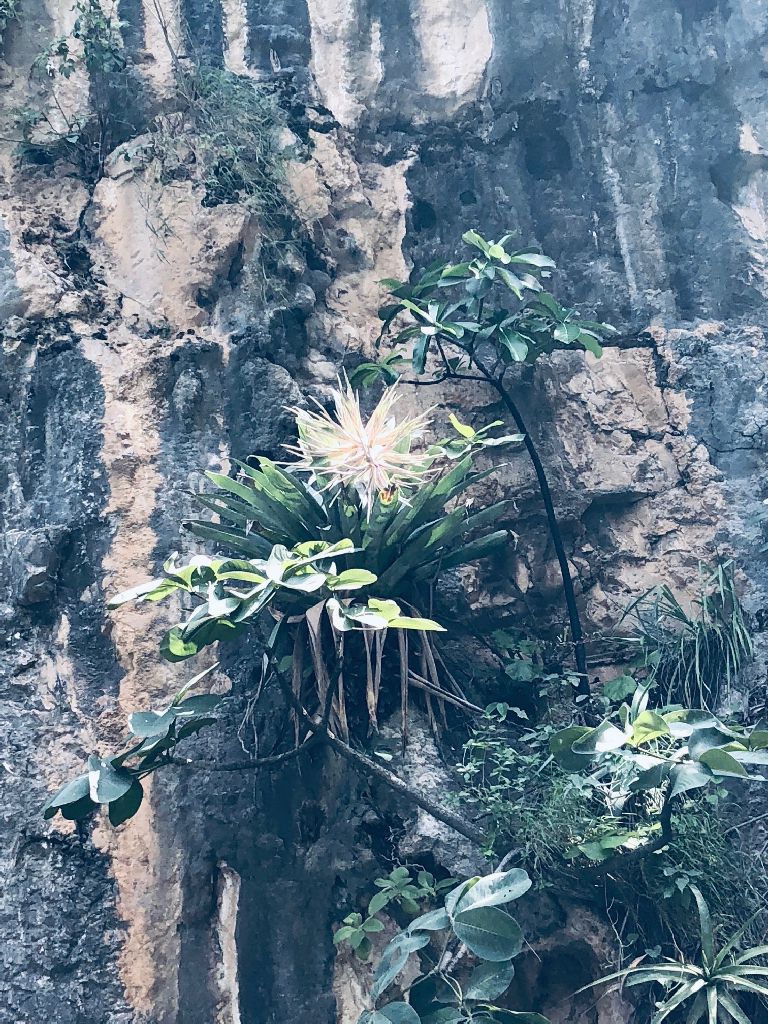
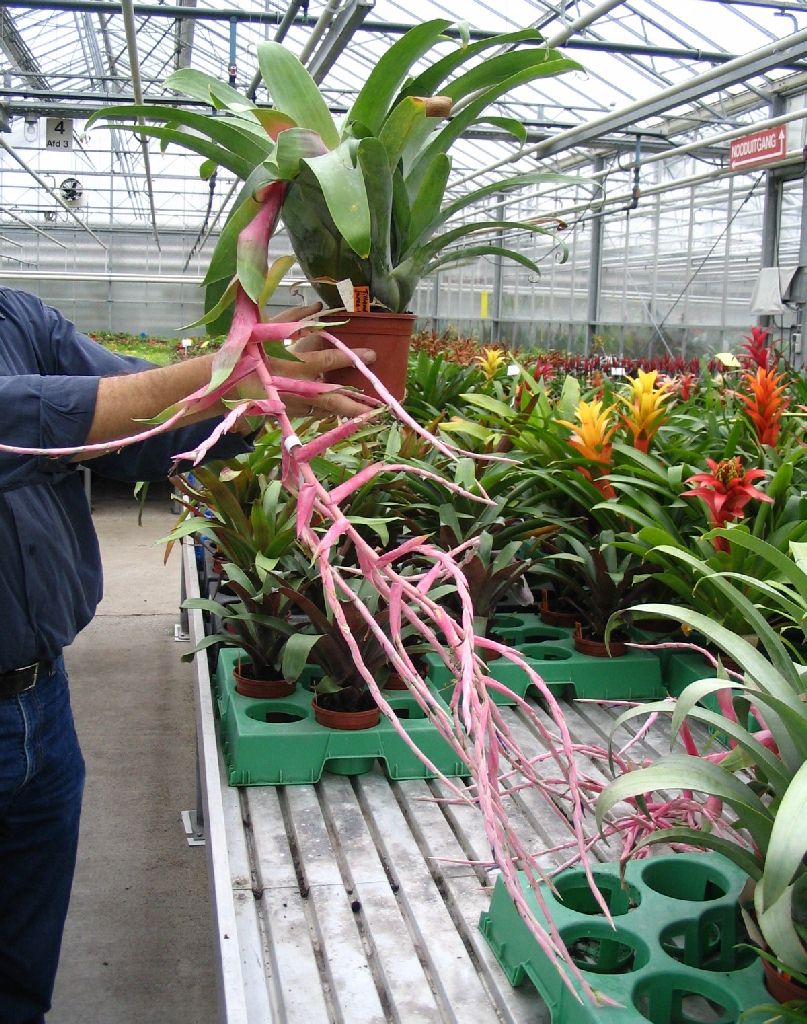
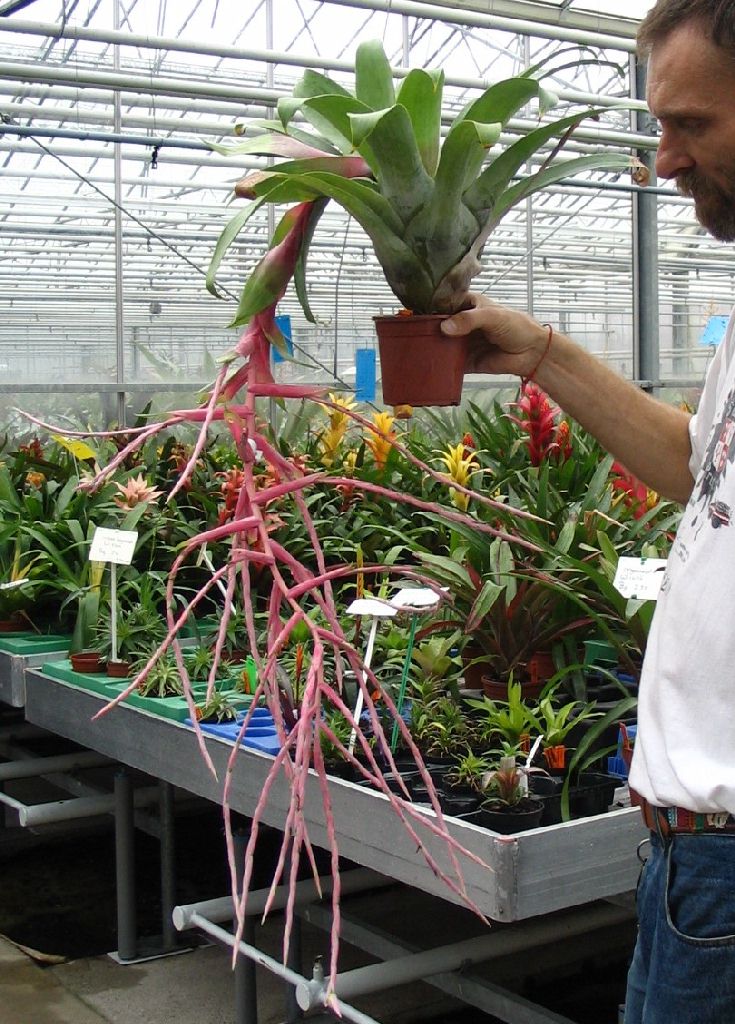
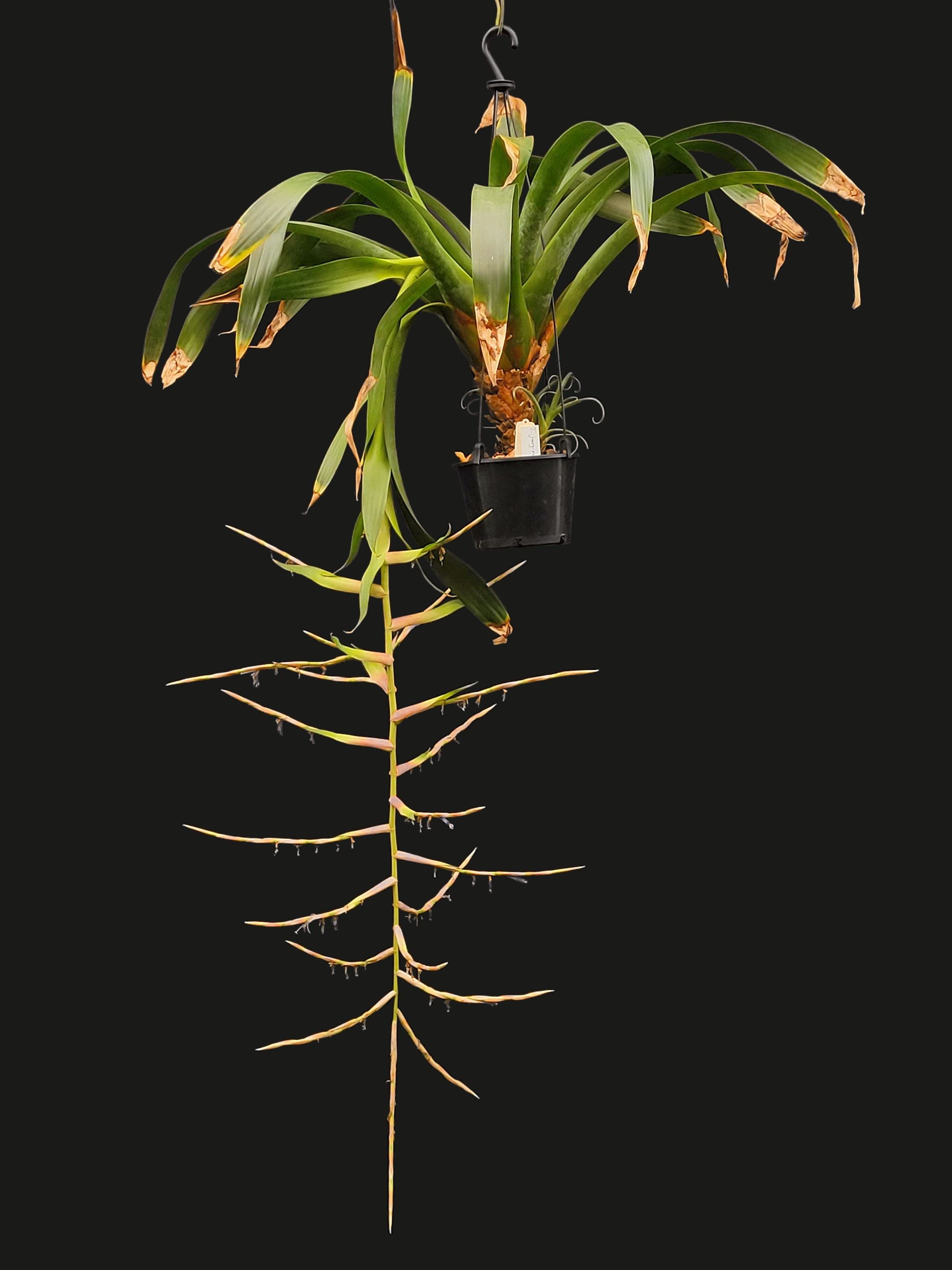
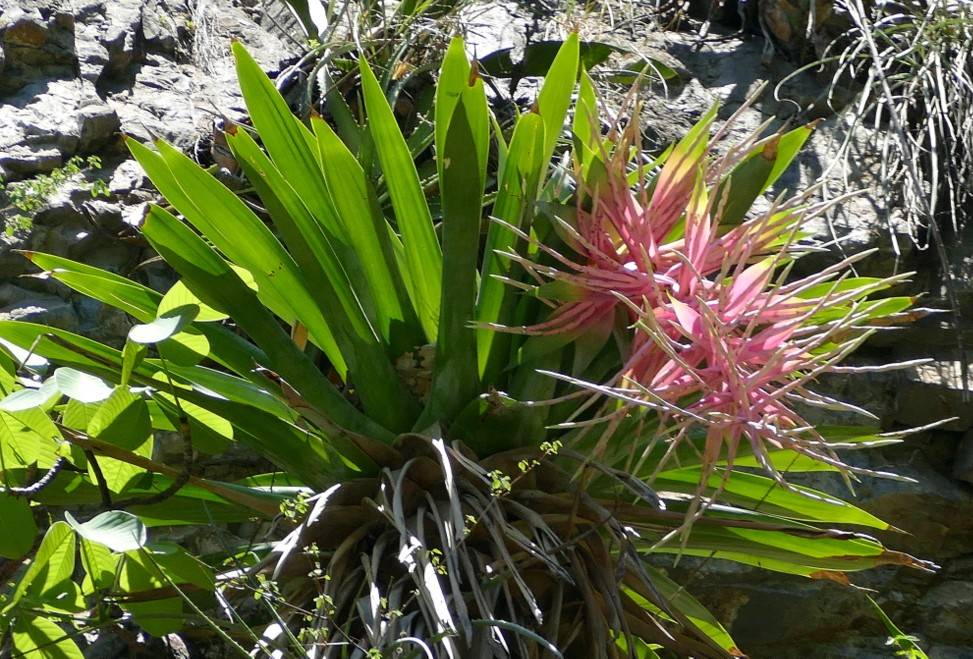
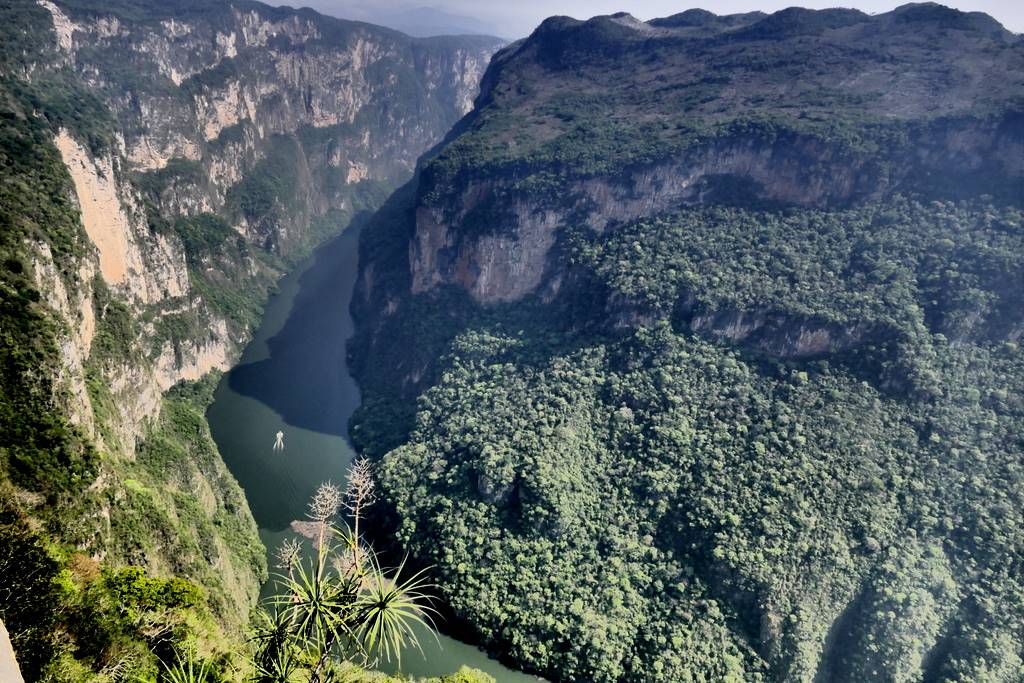
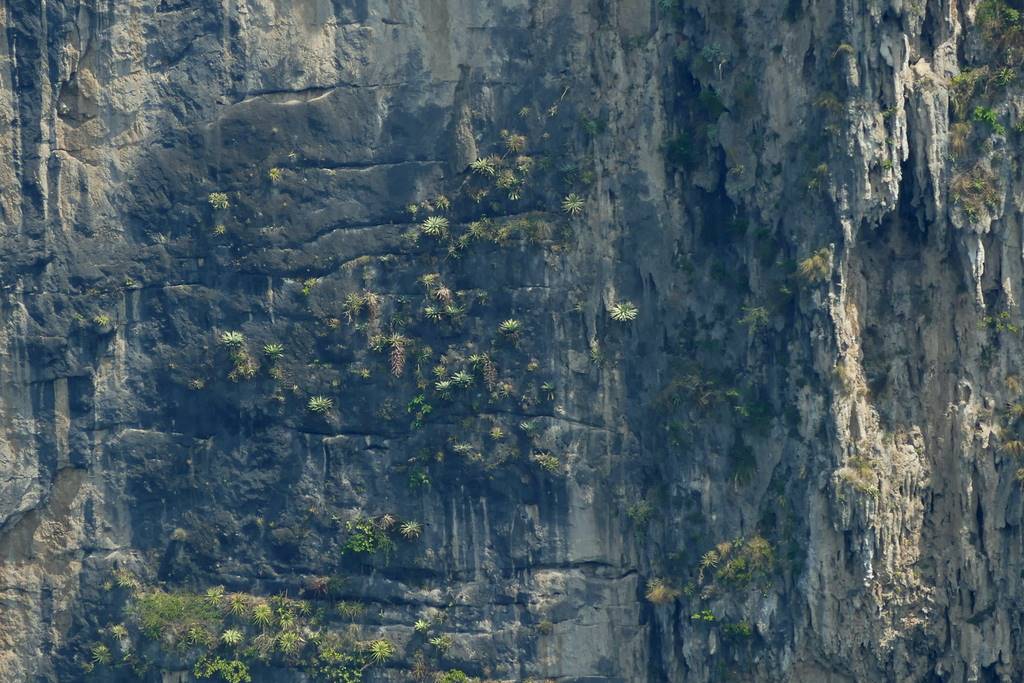
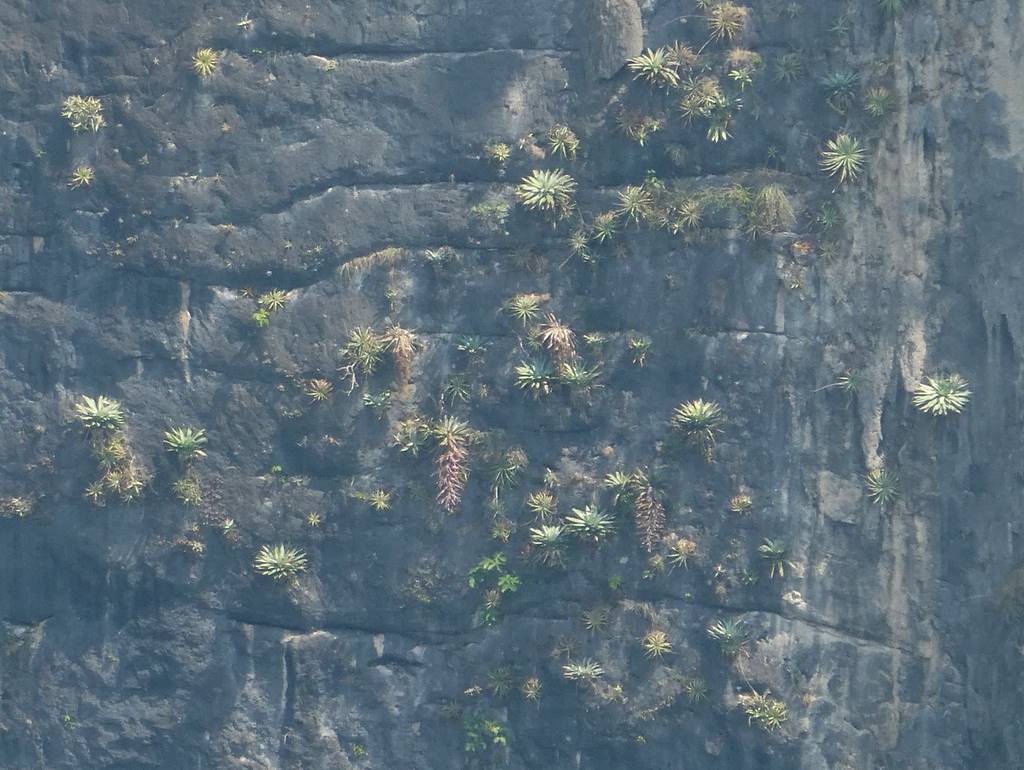


Holotypus : J. Rutschmann (sine numero) = Hort. hot. heidelb. 65 452; ramus lateralis et photographia in coloribus in herb. inst.bot. system. heidelb. (HEID).
Habitat et distributio: Mexico meridionalis (Chiapas), in faucibus Rio Grijalva, fauces Summidero, in parietibus arduis rupium calcareorum. Planta usque ad hoc tempus tantum e locotypi nota (Cf. Jurg Rutschmann: A giant Tillandsia from Southern Mexico, Journ. Bromeliad Soc. Vol. XXXIV, No. 3, 1984, S. 118-119).
Pflanze stammlos, im Alter haufig mit dicker, von alten Blattscheiden bedeckter und rhizomartiger Stammbasis und hangender Infloreszenz. Blatter zahlreich, eine bis 80cm hohe und bis 80cm breite Trichterrosette bildend; die inneren Rosettenblatter aufrecht, die ausseren, alteren herabhangend. Scheiden undeutlich, 10-20cm lang, +/- 10cm hoch, kastanienbraun. Spreiten ligulat, lang zugespitzt, 60-80cm lang, oberhalb der Scheide 8-10cm breit, beiderseits griin, zerstreut lepidot, verkahlend. Infloreszenzschaft kurz, in der Rosette versteckt, aufrecht-gebogen, von subfoliaten Schaftbrakteen umscheidet. Inf1oreszenz hangend, locker tripinnat, bis 1.5m lang; Auszweigungen 1. Ordnung +/- 20, locker spiralig angeordnet, rechtwinklig abstehend, bis 30cm lang (Abb. 34). Inf1oreszenzachse dunn, rosafarbig, kahl. Primarbrakteen langlich-3-eckig-zugespitzt, +/- 15cm lang, langer als der sterile, beblatterte Abschnitt der Seitenaste 1. Ordnung, aber viel kurzer als diese selbst, die Basis der Ahren scheidig umfassend, rosafarbig, kahl, zer-streut klein lepidot, in getrocknetem Zustand stark genervt. Ahren teret, bis 35cm lang, bluhend bis 1cm breit, mit schwach flexuoser Achse, frisch dicht imbrikat, getrocknet locker distich, vielblutig; Achse dann sichtbar. Florale Brakteen postfloral locker stehend, aufrecht, zweimal so lang wie die Internodien (bis 4cm), 1cm breit, langlich-lanzettlich-zugespitzt, kahl, ecarinat, getrocknet deutlich genervt, die Sepalen welt uberragend. Bluten kurz gestielt (3mm lang), bis 5cm lang, aufrecht, der Achse anliegend. Sepalen langlichlanzettlich, die hinteren carinat, +/-2cm hoch verwachsen, bis 25mm lang, 6mm breit, zugespitzt mit zuruckgerolltem Rand, membranos, kahl, rosafarbig. Petalen schmal-ligulat, lcm langer als die floralen Brakteen, blau-violett. Staubblatter und Griffel weit herausragend.
Holotypus : Rutschmann (ohne Nummer) = B. G.H. 65 452, im (HEID), Dez. 1983.
Heimat und Verbreitung: Sudmexiko (Chiapas), an steilen Kalkfelswanden der Schlucht des Rio Grijalva.
Die Pflanze ist bislang nur vom Typstandort bekannt, s. auch die Farbabbildung im Journ. Bromeliad. Soc. Vol. XXXIV, No. 3, S. 118-119; Juerg Rutschmann, A giant Tillandsia from Southern Mexico.
Es ist bislang keine derart gross Tillandsia aus Mexiko mit schlaff hangenden Infloreszenzen bekannt. Die gleichfalls sehr grog werdende T. grandis Schlechtendal, die ebenfalls in Zentral- und Sudmexiko verbreitet ist, besitzt aufrechte Blutenstande mit schwertformigen Ahren. Die vorliegenden Bestimmungstabellen fuhren zu der in der Prov. Mexico verbreiteten T. superinsignis Matuda, die bluhend 2m hoch wird und auf-rechte Infloreszenzen mit abwarts gebogenen Asten besitzt; auch sonst bestehen wesentliche Unterschiede zu T. juerg-rutschmannii. Bemerkenswert und auffallig ist, dag nach Beobachtungen von Rutschmann alle grossen, bluhfahigen Pflanzen nahezu gleichzeitig ihre Infloreszenzen entfalten, ein Phanomen, das auch fur andere, vor allem steile Felswande bewohnende Tillandsien festgestellt werden kann. Verf. selbst beobachtete die gleiche Erscheinung bei Puya raimondii in der Cordillera blanca (Zentralperu) : Alle bluhfahigen Exemplare entfalteten ihre machtigen Infloreszenzen zu gleicher Zeit und alle befanden sich auf dem gleichen Entwicklungsstadium. Es vergehen dann wieder Jahre, bis eine neue Bluh “welle" einsetzt.
Translated by Butcher
Plant stemless, when old the abundant older leaf sheaths cover the rhizome base, inflorescence hanging.
Leaves numerous, making a 80cm high, 80cm wide, funnel rosette, the inner leaves erect, the outer and older hanging downwards.
Leaf sheath indistinct, 10 –20cm long, ca. 10cm high, chestnut brown.
Leaf blade ligulate, long acuminate, 60 – 80cm long, 8 – 10cm wide near sheath, both sides green, scattered lepidote, otherwise glabrous.
Scape short, hidden, erect to bent, covered by the leaflike bracts.
Inflorescence hanging, laxly tripinnate, to 1.5m long.
Primary branching ca 20 laxly arranged spirally, sticking out at right angles, to 30cm long.
Inflorescence rhachis thin, pink coloured, glabrous.
Primary bracts longish triangular, acuminate, ca. 15cm long, longer than the sterile leafy section of the side spike, but much shorter than the whole, the sheaths entirely cover the bottom of the spike, pink coloured, glabrous, scattered small lepidote, in a dry state strongly nerved.
Spike tubular, to 35cm long, flowering to 1cm wide, with weakly flexuous rhachis, when fresh densely imbricate, when dry laxly distichous, many flowered, rhachis then visible.
Floral bracts after flowering laxly upright, erect, twice as long as the internodes (-4cm), 1cm wide, longish lanceolate-acuminate, glabrous, not keeled, when dry distinctly nerved, much exceeding the sepals.
Flower short stemmed (3mm long), to 5cm long, erect, adjacent to the rhachis.
Sepals longish lancelike, the posterior ones keeled, ca. 2cm connate, to 25mm long, 6mm wide, acuminate with rolled back edges, membranous, glabrous, pink.
Petal thin ligulate, 1cm longer than the floral bract, blue-violet.
Stamens & Style widely protruding.
Type locality South Mexico, Chiapas, on steep chalky cliffs in the canyon of Rio Grijalva.
Holotype Rutschmann s.n. = BGH 65 452 HEID
Habitat and range: South Mexico (Chiapas), on steep limestone rocks in the canyon of the Rio Grijalva.
The plant is known only from the Type locality up to now, see also the article in the Journ. Bromeliad. Soc. Vol. XXXIV, nr., 3, p. 118-119; Juerg Rutschmann, A giant Tillandsia from Southern Mexico.
Nobody has known a large Tillandsia with a lax hanging inflorescense from Mexico up to now. The similarly very large T. grandis Schlechtendal, also dispersed in central and South Mexico, has an erect inflorescence with sword shaped spikes. The present Key leads to the dispersed T. superinsignis Matuda in the Prov. of Mexico, that flowers 2m high and has an erect inflorescence with downward bent branches which are the essential differences from T. juerg-rutschmannii.
Remarkable and striking is the observation of Rutschmann that all large flowering size plants virtually simultaneously develop their inflorescences, a Phanogam, and that also applies for other Tillandsias growing on steep rocks. Indeed the same can be observed with Puya raimondii in the Cordillera blanca (central Peru): universal flowering size examples develop their powerful inflorescenses at the same time and all at the same development stage. Years pass again then, until a new flowering “wave" starts.
A Giant Tillandsia From Southern Mexico by Jurg Rutschmann in J. Brom. Soc. 34(3): 118-120. 1984
The tributaries of the Rio Grijalva, or Rio Chiapa, enter Mexico from Guatemala, and the river then runs through the wide depression between the Sierra Madre and the Chiapas highlands. Near the rapidly growing, modern capital of the state of Chiapas, Tuxtla Gutierrez, it breaks through a high limestone range on its way to the Tabasco lowlands and, ultimately, the Gulf, forming the tremendous Sumidero Gorge. For about twenty kilometers, the river flows between nearly vertical rock walls up to about 1,000 meters in height.
The river is dammed in three places for electricity production forming huge reservoirs, one of them, above the Chicoasen dam, occupying the whole length of the gorge. The water, previously very rapid, is, therefore, quiet nowadays and can be navigated with launches.
Near the entrance to the gorge, the river is crossed by the famous Pan-American highway bridge of Chiapa de Corzo. The immediate surroundings of this bridge are the type locality of the very pretty Tillandsia ionantha var. vanhyningii M. B. Foster and of T. socialis L. B. Smith. From the upper rim of the rock face below the vantage point "El Mirador" T. beutelspacheri Matuda has been described. From these findings, it seemed that the region had been well explored, especially since it is comfortably accessible being less than thirty minutes from a major town with a university and a botanical garden.
It was all the more a surprise when we visited the canyon in December of 1983 to observe a profusion of flowering plants of a presumably new, large tillandsia growing on the vertical rock walls from the upper rim near El Mirador down to the water, that is, an altitude difference of more than 900 meters. The species seems to prefer the rock faces not too much exposed to the sun, whereas the silvery-rose hanging cushions of vanhyningii, the tufts of beutelspacheri with its yellow, decurved inflorescences, and the rarer socialis grow in very sunny places.
The characteristics of the species, in my opinion, set it clearly apart from any other Mexican member of the genus. It forms a large rosette of green, flat, pointed leaves about 60 cm long and 8 cm wide. The tripinnate inflorescence is pendent and up to 150 cm long, consisting of a relatively thin axis and compound branches emerging from beneath rose-colored, spreading primary bracts about 10 cm long and 3-4 cm wide. The branches divide into 2-4 terete, roseate spikes, about the thickness of a pencil and up to 35 cm long, spreading horizontally. The flower bracts are imbricate, ecarinate and also roseate, the flowers violet with the stamens exserted. They are visited by hummingbirds.
Most of the plants were in flower; almost no immature or juvenile specimens could be seen when searching the rocks with the binoculars. The plant community, therefore, seems to be highly synchronized, a phenomenon which has been observed in other species and which might explain why the plant, although very conspicuous when flowering, has not been noticed up to now. Vegetatively it could perhaps be mistaken for T. grandis, T. viridiflora, or a Vriesea. But quite apart from the interesting botanical aspects of the Grijalva Gorge, it is in our opinion one of the most worthwhile sights in Mexico, especially when visited by boat.
The plant presented here will be described scientifically and named by Prof. Werner Rauh, of Heidelberg, if its novelty is established beyond any doubt.
In 1984, Jurg Rutschmann reported a new species of Tillandsia growing on the steep, limestone walls of Canon del Sumidero, near Tuxtla Gutierrez, the capital of Chiapas, Mexico. Astounded that this bromeliad with its large, striking inflorescence, could remain unknown within the confines of the popular Parque Nacional del Sumidero, he sent a specimen for verification to Werner Rauh in Heidelberg. Professor Rauh (1985) subsequently described the species and named it in honor of Rutschmann: Tillandsia juerg-rutschmannii Rauh (Lineham 1990).
How this extraordinary tillandsia escaped the attention of previous botanical surveys of the canyon is indeed problematic. At the time of discovery, Rutschmann (1984) noted that most of the specimens were in flower. While giving no indication of the relative abundance, he did mention the near absence of any immature or juvenile specimens. He further suggested that this was a highly synchronized plant community in which plants flower within a given span of time. Thus, unless an observer was fortunate to be in the canyon during this period, the species could go unnoticed.
Tillandsia juerg-rutschmannii is currently known to grow only at this cliff site. The plants cling to sheer rock faces that soar 800 meters above the Rio Grijalva as it flows through a deep, narrow channel in the gorge on its course to the Gulf of Mexico. The isolated habitat is located a few kilometers down river from the mouth of Canon del Sumidero, a geological landmark defining where the Central Depression of Chiapas ends and the Chiapas Plateau or Highland Chiapas begins.
In January, 2000, we observed a flowering specimen of T. juerg-rutschmannii from the edge of the canyon at an altitude of 1200 meters. Needing a better look at the species, we engaged a boatman from the nearby embarcadero to transport us to the area on the river directly below. The launch, by far, provided the best viewing platform to examine a few examples at close range, and to scan others with binoculars. The population appeared to extend for about two kilometers on the river where we estimated some four hundred plants, in varying sizes and stages of development, scattered on the canyon walls. From our vantage point, we saw only solitary plants. Most grew on the shadier, east facing cliffs, from slightly above the water level at an altitude of 400 meters up to the sharp rim of the canyon.
The plant bodies form dense, upright rosettes that can be mistaken, from a distance, for a Vriesea or other soft-leafed, large-bodied Tillandsia. They attain a height of approximately 50 centimeters, with broad, green leaves, about 60 centimeters long and 10 centimeters wide. Even in the dry season, these rosettes fill with moisture from the mists that often shroud this breath-taking gorge. The pale-pink, pendulous inflorescences with pencil-thin scapes and spikes are well camouflaged amidst the deep shadows cast by the soaring cliffs. The primary bracts, a rose color on the surface exposed to the sun, appear pale green when viewed from the underside.
We observed only two plants in flower: one, on the rim of the canyon, suspended precipitously from the edge; and the other, some five meters above the river. The small, delicate, violet flowers can barely be seen on the cascading inflorescence which extends to over 150 centimeters long. Although we noted no axillary offshoots on any of the plants, we did see adventitious offsets on the bases of several maturing specimens. Within our limited viewing range, we saw only six plants with dried inflorescences, most with evidence of recent flowering. Only one of the older specimens was in the dehiscent phase.
Of the over 160 species of Bromeliaceae recorded for Chiapas, Tillandsia eizii L.B. Smith is one with several characteristics similar to T. juerg-rutschmannii. Both are endemic, noteworthy for their pendulous inflorescences, known to reproduce primarily by seeds, and require years to reach maturity. In addition, adventitious offsets are often found on both species. They inhabit, however, different environmental niches.
In contrast to the relatively unknown, saxicolous T. juerg-rutschmannii, T. eizii, with a robust, pink inflorescence, up to two meters long, is a well documented epiphyte of Highland Chiapas. It grows at altitudes ranging from 1200 to 2400 meters in the oak-pine forests of the Central Plateau, some fifty kilometers east of Canon del Sumidero, and even farther afield in the Sierra Madre and northern highlands. Although T. eizii has also been reported in the Department of Huehuetenango (western highlands of Guatemala), we have no recent evidence that the species survives in this heavily-deforested region.
Tillandsia eizii is named after Eizi Matuda, a Japanese-born botanist who arrived in Chiapas in 1922, and later became a leading authority on the flora of the state with a special interest in bromeliads. In 1951, he collected a tillandsia from the forest at Siltepec, in southeastern Chiapas, at an altitude of 1200 meters, identifying it as T. violacea. The plant eventually made its way to the United States National Herbarium. A number of years later, L.B: Smith (1977) re-examined the specimen, described it as a new species, and named it in honor of Professor Matuda.
Even with its high visibility and notoriety, T. eizii has been plagued by an unfortunate confusion in nomenclature. This may in part be due to a somewhat superficial resemblance to other pendulous bromeliads from other states of Mexico, namely T. prodigiosa (Lemaire) Bake and T. violacea Baker. More importantly, however, T. eizii was not described until 1974, well after the appearance of numerous publications about a pendulous tillandsia used in Chiapas for religious ceremonies and decorative purposes. In these accounts, the plant was identified either as T. prodigiosa, or more often, as T. violacea.
While Blackburn (1982) clearly outlined the differences between T. eizii and T. prodigiosa, a similar distinction has not been made between T. eizii and T. violacea. Only Utley (1994) notes that since T. violacea is not known to occur in Chiapas, all references to a pendulous tillandsia in that state as T. violacea undoubtedly refer to T. eizii.
With an increasing population in Highland Chiapas asserting new demands for land once covered by dense forests, the numbers of T. eizii are in sharp decline. Where ten years ago the species could be easily seen throughout the Highlands, now it exists in abundance only in pockets of more remote forests. As an indication of diminishing numbers, during the Christmas season of 1999, when we would expect the market of San Cristobal de Las Casas to be filled with bromeliads, we found only a handful of T. eizii.